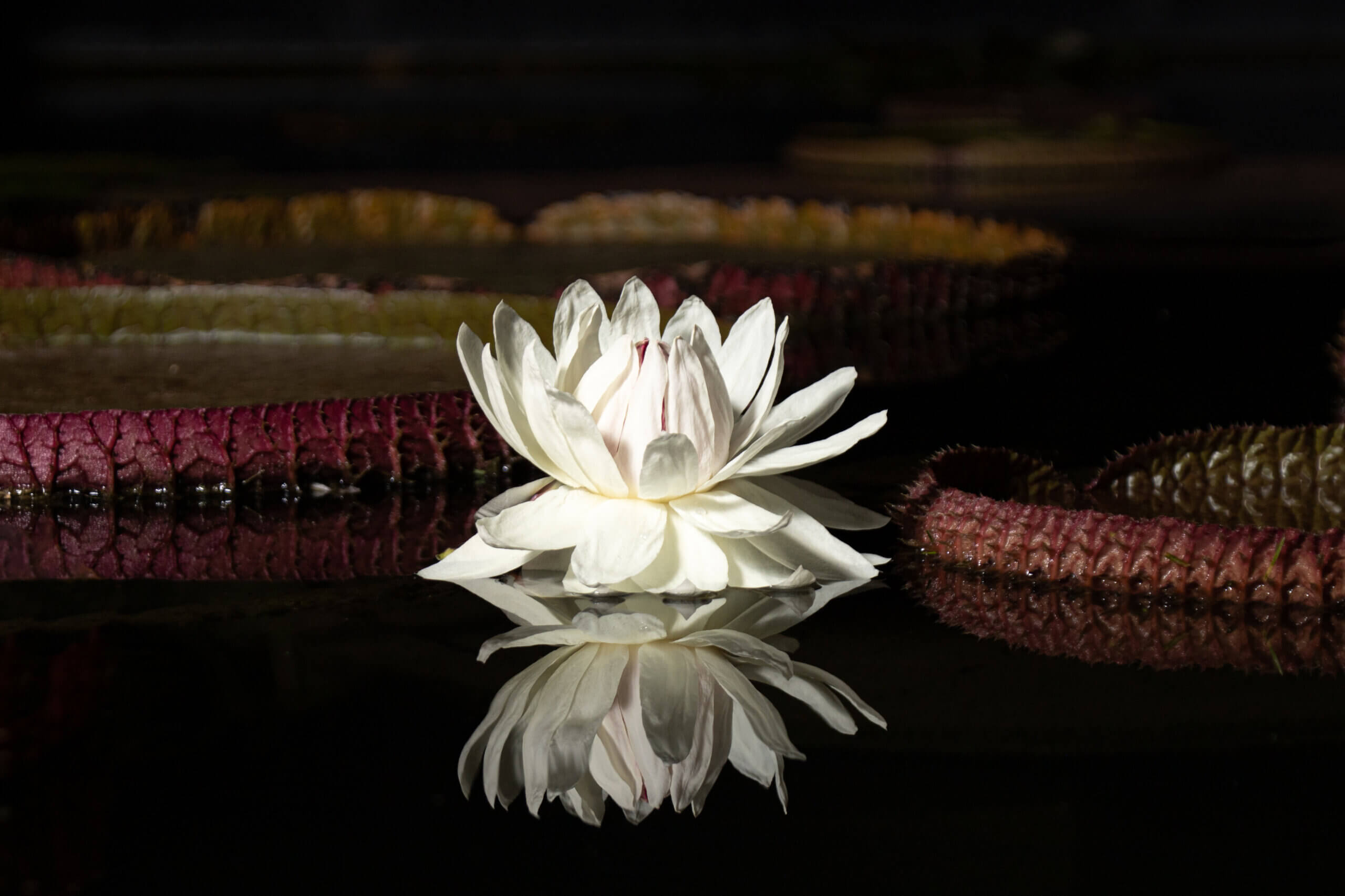Did you Know:
- The Victoria produces the second largest single leaf of any plant in the world (over 8′ 6″ in diameter!)
- Each leaf can grow up to 10″ in a single day
- Native South Americans use Victoria seeds as flour for cakes
- The Victoria is over 160 million years old-it appeared when South America was still connected to Africa and Antarctica. That makes it 10 million years older than the earliest ancestor of modern birds
- The Victoria is hermaphroditic: when it blooms, it changes from female to male overnight
- Its thorns, found on the “ribs” on the underside of the leaf, are sharp enough to puncture rubber
- The structure of its leaves inspired the architecture of England’s first greenhouse, the “Crystal Palace,” in 1851
In the Amazon …
The native Victoria is found only in South American river basins. In its natural habitat, the Victoria is an annual plant which appears above the water surface during the early months of spring and stays throughout the summer and early fall. There are two naturally occurring species of Victoria, the Victoria amazonica and the Victoria cruziana. The two species share several characteristics. Both types are primarily identifiable by their amazing leaves. Each plant displays several leaf pads at a time, which can grow to more than 8′ in diameter, expanding up to 20″ in a single day. The leaf size directly correlates to the air temperature, water temperature, and water depth. Each leaf has a life-span of approximately four weeks.
In Bloom …
For the majority of the year, the Victoria is distinguishable only by its leaves. However, it does produce night-blooming flowers that appear for only 48 hours once a year, in late July to early August. At this time, the Victoria has reached maturity and will begin to produce one flower every few days. Each Victoria plant generates about 10-12 flowers per season.
The day before the plant flowers, a tennis-ball sized bud rises out of the water. At sunset on the first night of its bloom cycle, the bud opens to reveal a 50+ petal bloom that may be up to 18″ in diameter. The bloom is sharply white and “glows” in the darkening night sky. As the flowering Victoria opens, it emits a strong fragrance of tuberose, pineapple and banana that can be sensed from 20 – 30 feet away. It also radiates heat and is considerably warmer than the surrounding air. At this stage, the Victoria is female, seeking to be pollinated.
The bright flower, heat, and strong fragrance combine to attract pollinating scarab beetles. Several pollen-covered beetles enter the flower and stay for the night, feasting on the starchy nectar. As dawn approaches, the temperature of the flower cools, and the fragrance disappears. The bloom closes and traps the beetles inside for the day, allowing the pollen-covered beetles to fertilize the Victoria.
At sunset of the second night, the bloom re-opens and the beetles are released. At this point, the flower has pink or red petals, and has changed not only color, but gender as well– it is now male. The beetles leave in search of a first-night blooming Victoria, and the original flower remains open for the rest of the night. After the second night ends, the pollinated flower sinks back into the water, allowing the seeds to germinate and mature.
In Colorado …
The scarab beetle is native only to South America, and thus Victorias raised in the United States must be artificially pollinated. However, the plants still undergo the same flowering process, and the Victorias seen at The Hudson Gardens demonstrate the bloom cycle in its entirety.
Most of the Victoria lilies found in Colorado, including those at The Hudson Gardens, are Victoria ‘Longwoods’, or
‘Longwood Hybrids.’ This hybrid was selected for the Colorado climate primarily because it is heartier and makes a more beautiful display plant than either of its parents (V. amazonica and V. cruziana). The ‘Longwood’ captures the beautiful red leaf of the amazonica with the stunning rim found on the cruziana. It tolerates cooler temperatures, is easier to maintain, and stands up stronger amidst high winds.
Several characteristics of Colorado’s climate influence the way that Victorias grow and distinguish them from their Amazon counterparts. The most noticeable difference is that Victorias in Colorado are raised as annuals that die completely with the first freeze of the late fall or winter. While they may simply go into dormancy in tropical zones and conservatories, harsh Colorado winters prevent this from occurring. Instead, the Victorias seen at The Hudson Gardens are raised from seed each spring and transplanted to the pond when temperatures will allow them to survive.
Another noticeable difference is the size of Victorias in Colorado. The size of the plant is limited not only by the cooler air and water temperatures, but also by the size of the container that houses its root ball. All of the Victorias displayed at
The Hudson Gardens rest in pots and require weekly nutrition and removal of deteriorating leaves. Although they have no resistance to local pests, they don’t have any natural predators and are compatible with most pond creatures.
At Hudson Gardens …
The Victorias at Hudson Gardens were first donated and introduced in 1997 and have been flourishing ever since. Like all aquatic plants at The Hudson Gardens, they are maintained by a dedicated group of volunteers from the Colorado Water Garden Society.
The Victoria Water Lily Pond was constructed in 2012 to house the Victoria Water Lily collection. It measures 25′ in diameter and is surrounded by a sunken brick paver plaza complete with sitting spots and lighting for night-time viewing. The Pond is approximately 3′ deep and filled with irrigation water. Water quality is maintained through biological filtration performed by the raised bog situated on the north side of the Pond. Water is pumped from the body of the Pond and up through the gravel that forms the foundation of the bog. The bog is filled with plants whose roots act as filters, absorbing nutrients from the water before they become a food source for algae, effectively “starving” algae out of the water. After being pumped through the bog, the freshly filtered water is distributed back into the Pond via the waterfall.
Victoria’s Milestones:
- 1801: Victoria amazonica and Victoria cruziana discovered in Bolivia
- 1849: Brought to Europe
- 1851: Makes its first public appearance in Britain’s “Crystal Palace”
- 1851: Brought to U.S.A.
- 1960: Victoria ‘Longwood’ is created in Pennsylvania
- 1997: Victoria ‘Longwood’ is introduced to The Hudson Gardens


